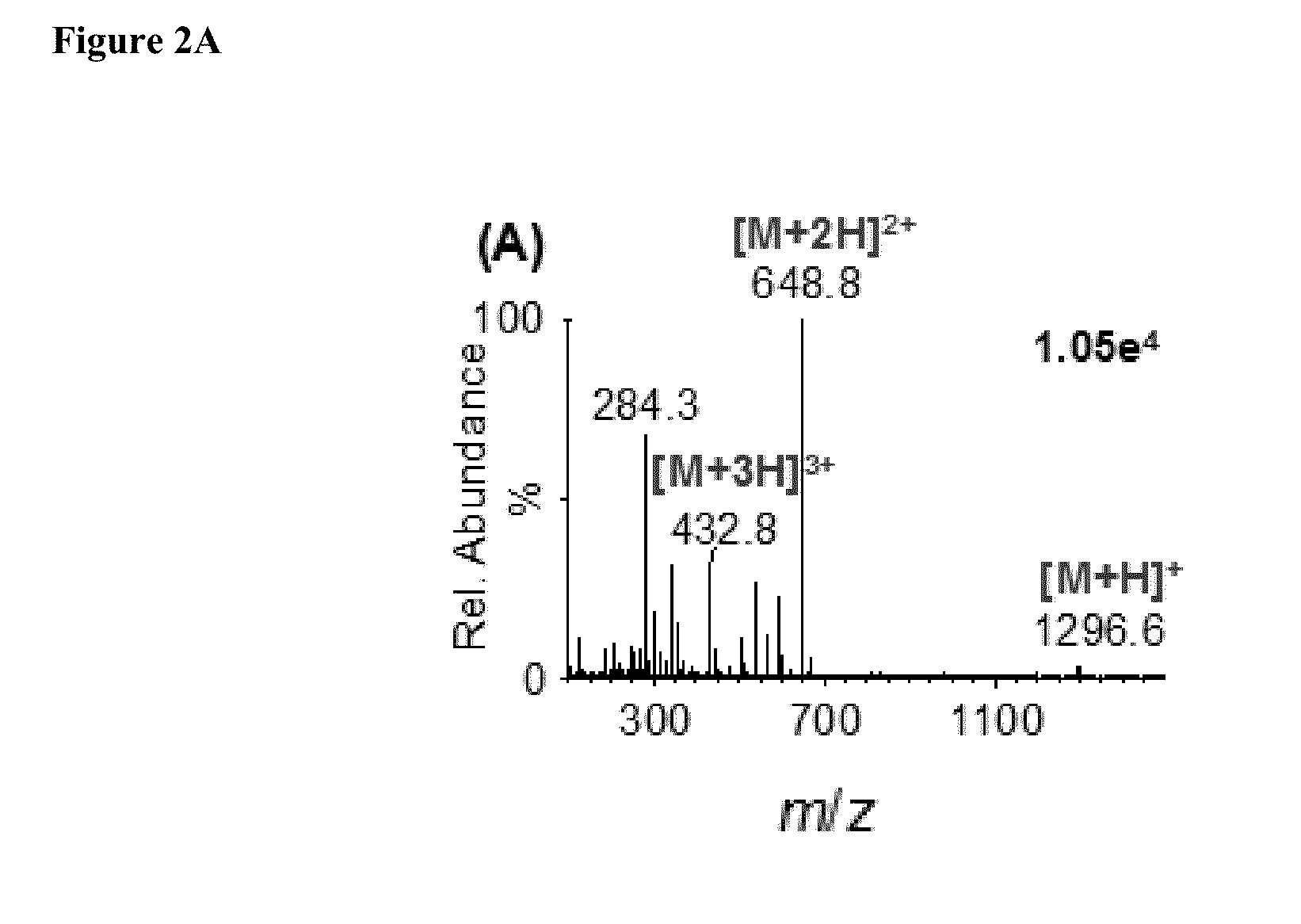Compositions and methods for mass spectometry
a mass spectrometry and composition technology, applied in chemical methods analysis, particle separator tube details, instruments, etc., can solve the problems of high energy input, difficult preparation of suitable samples, time-consuming, etc., to improve selectivity and specificity, increase the sensitivity, the effect of universal nature and improving the solubility of analyte solutions
- Summary
- Abstract
- Description
- Claims
- Application Information
AI Technical Summary
Benefits of technology
Problems solved by technology
Method used
Image
Examples
example 1
[0077]MAIV was performed on a Waters SYNAPT G2 (Waters Corporation, Milford, Mass.) from atmospheric and intermediate pressure using commercial Z-Spray and intermediate pressure vacuum MALDI sources, respectively. The atmospheric pressure ESI source housing was removed and interlocks overridden. A commercial Z-Spray source cone was used for matrix-analyte introduction by pipet tip. A modified cone with a widened inlet of ca. 3 mm was used for matrix-analyte introduction by a glass microscopy slide. The atmospheric pressure source was operated with the source block temperature varied from 30 to 150° C. The intermediate pressure vacuum source (˜0.16 Torr) was operated at ambient temperature with ion extraction near 0 V and the laser turned off, i.e., laserspray ionization vacuum settings. Matrix-analyte samples were spotted onto stainless steel MALDI target plates before inserting into the intermediate pressure source of the SYNAPT G2 mass spectrometer. The mass spectra...
example 2
Testing Ionizing Matrices
[0078]We analyzed the ionization properties of three of the representative room temperature liquid matrix compounds ((1) 1,3-dimethyl-2-nitrobenzene, (2) 3-methoxybenzonitrile, and (3) methyl-4-methyl-4-nitropentanoate) using the peptide angiotensin I as the analyte (FIGS. 2A-2C). Specifically, one microliter of a solution containing matrix and analyte was drawn into a pipet tip and brought in contact with dry ice to freeze the mixture. Care was taken that the aqueous solution of the analyte was removed prior to freezing the matrix-analyte to obtain the solid state crystal. Dry ice was used as a sample support to introduce the solidified matrix-analyte sample to the Z-Spray inlet aperture operated at 30° C. Care was also taken to avoid melting during sample introduction by having a small gap between the solid matrix-analyte and the inlet aperture. Cracking was observed as the matrix froze splintering off matrix-analyte which entered the inlet.
[0079]FIGS. 2A-...
example 3
Additional Applications of Matrix-Analyte Compositions
[0086]Compounds such as ganglioside lipids have eluded characterization using inlet or vacuum ionization because of insufficient heat on the Waters Z-Spray source and harsh conditions on the intermediate pressure source, respectively. Through fundamental studies, a number of ionizing matrix compounds were found to consistently produce high analyte ion intensity with good spectral quality based on signal-to-noise ratio, chemical background, mass resolution and accuracy (for accurate mass determination) and ion mobility resolution over a larger range of solvents, temperatures, and source conditions for peptides, proteins, ganglioside lipids and polyethylene glycol (PEG). On the atmospheric pressure Z-Spray source, 10 fmol of bovine insulin (FIG. 9A) was detected using the matrices (1) phthalonitrile, (2) 5-bromo-3-nitropyridine-2-carbonitrile, and (3) 4-methyl-phthalonitrile also demonstrated exceptional sensitivity, ionizing 50 f...
PUM
 Login to View More
Login to View More Abstract
Description
Claims
Application Information
 Login to View More
Login to View More - R&D
- Intellectual Property
- Life Sciences
- Materials
- Tech Scout
- Unparalleled Data Quality
- Higher Quality Content
- 60% Fewer Hallucinations
Browse by: Latest US Patents, China's latest patents, Technical Efficacy Thesaurus, Application Domain, Technology Topic, Popular Technical Reports.
© 2025 PatSnap. All rights reserved.Legal|Privacy policy|Modern Slavery Act Transparency Statement|Sitemap|About US| Contact US: help@patsnap.com



